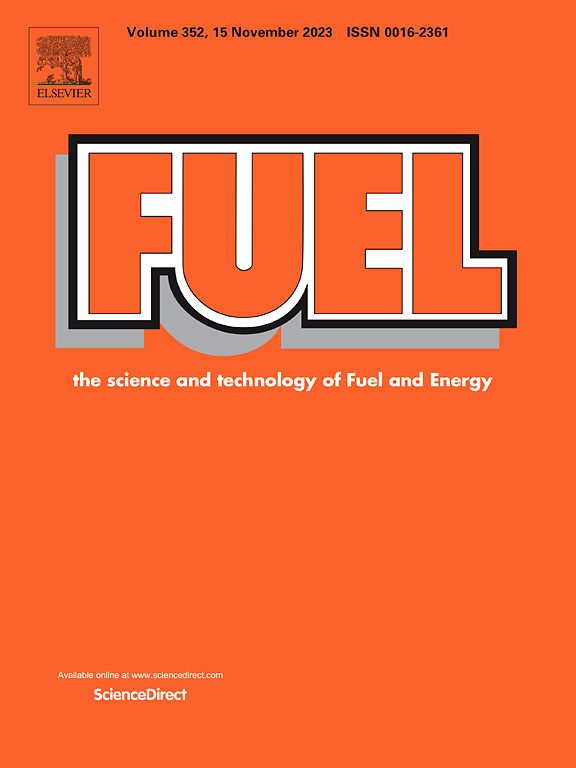双喷策略下二乙醚-柴油混合物的宏观喷雾特性
IF 7.5
1区 工程技术
Q2 ENERGY & FUELS
引用次数: 0
摘要
测试燃料的物理化学性质、环境条件和燃油喷射策略对喷雾特性有很大影响。实验研究了双裂喷射策略下二乙醚-柴油混合燃料的宏观喷雾特性。柴油-乙醚混合物(DEE40,柴油中40%乙醚,v/v)喷雾在喷雾演化初期渗透速度更快,喷雾渗透率更高。然而,在喷雾演化的后期阶段,液体穿透长度与之相当或更低。乙醚喷雾密度较低。因此,在注射开始时观察到DEE40喷雾的注射速度较高。然而,远场速度完全取决于喷雾液滴的进一步破碎和蒸发。柴油-乙醚混合物在喷油器内表现出更强的空化,与基线柴油相比,改善了喷雾雾化。在远场,乙醚的蒸气压越高,燃料液滴随着喷雾的演化而蒸发得越快。两种试验燃料的液体喷雾面积与液体穿透长度也表现出相似的趋势。DEE40喷雾不仅具有较高的轴向穿透性,而且具有较高的径向扩散性。然而,DEE40的快速雾化和蒸发显示液体渗透长度和喷雾面积突然减少。在1200 bar的燃油喷射压力下,由于喷射动量较大,两种测试燃料的液体穿透长度均大于700 bar。停留时间为0.15 ms的分段注射比单次注射具有更高的喷雾穿透性。来自第二个喷射脉冲的直接推力加速了整个燃油喷射的动量。此外,过短的停留时间会促进液滴的碰撞和聚并,增加液体的渗透长度。停留时间较长(0.45 ms)和DEE40喷雾可以形成更细的液滴,由于这些更细的液滴蒸发得更好,液体喷雾面积更小。本文章由计算机程序翻译,如有差异,请以英文原文为准。

Macroscopic spray characteristics of diethyl ether-diesel blends in a double injection strategy
The physicochemical properties of test fuels, ambient conditions, and fuel injection strategies strongly influence the spray characteristics. This study experimentally investigated the macroscopic spray characteristics of diethyl ether-diesel blend under a double-split injection strategy. Diesel-diethyl ether blend (DEE40, 40 % diethyl ether in diesel, v/v) spray penetrated faster in the initial stage of spray evolution and exhibited a higher spray penetration rate. However, the liquid penetration length of the spray was comparable to or lower in the later stages of the spray evolution. Diethyl ether spray had a lower density. Hence, a higher injection velocity for DEE40 spray was observed at the start of the injection. However, far-field velocity completely depends on spray droplets’ further breakup and evaporation. Diesel-diethyl ether blends exhibited stronger cavitation inside the injector, improving the spray atomisation compared to baseline diesel. In the far field, the higher vapour pressure of diethyl ether enhanced fuel droplet evaporation with the spray evolution. The liquid spray area also showed similar trends to the liquid penetration length for both test fuels. DEE40 spray not only showed higher axial penetration but also radial spread. However, rapid atomisation and evaporation of DEE40 showed a sudden reduction in liquid penetration length and spray area. The fuel injection pressure of 1200 bar had a higher liquid penetration length than 700 bar for both test fuels due to higher spray momentum. A split injection with a dwell time of 0.15 ms showed higher spray penetration than a single injection case. The immediate push from the second injection pulse accelerated the momentum of the entire fuel spray. In addition, too short dwell time promoted droplet collision and coalescence, increasing the liquid penetration length. The longer dwell time of 0.45 ms and DEE40 spray showed the formation of finer droplets and a lower liquid spray area due to the superior evaporation of these finer droplets.
求助全文
通过发布文献求助,成功后即可免费获取论文全文。
去求助
来源期刊

Fuel
工程技术-工程:化工
CiteScore
12.80
自引率
20.30%
发文量
3506
审稿时长
64 days
期刊介绍:
The exploration of energy sources remains a critical matter of study. For the past nine decades, fuel has consistently held the forefront in primary research efforts within the field of energy science. This area of investigation encompasses a wide range of subjects, with a particular emphasis on emerging concerns like environmental factors and pollution.
 求助内容:
求助内容: 应助结果提醒方式:
应助结果提醒方式:


